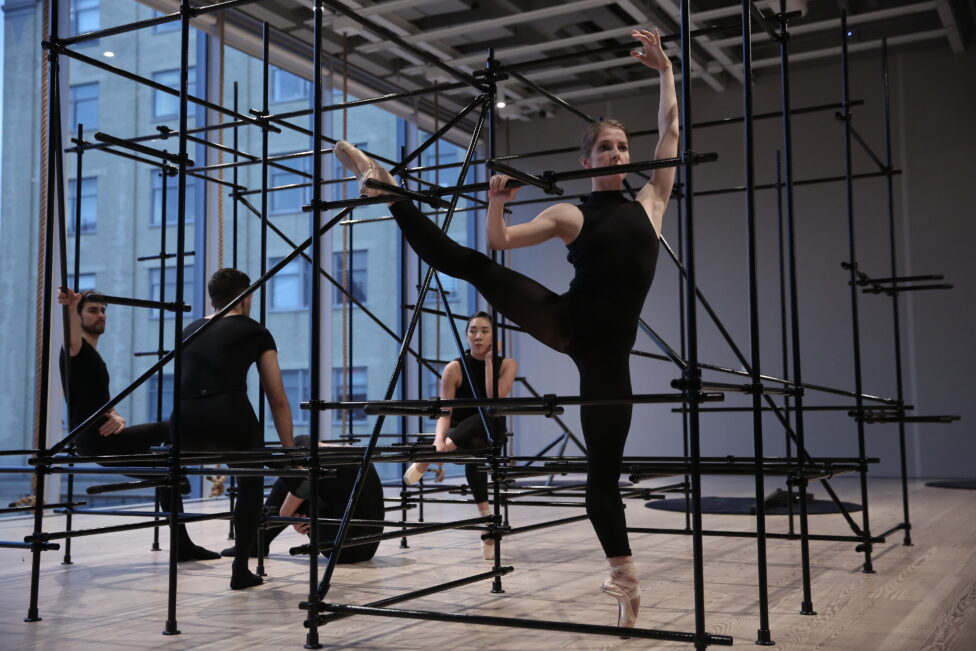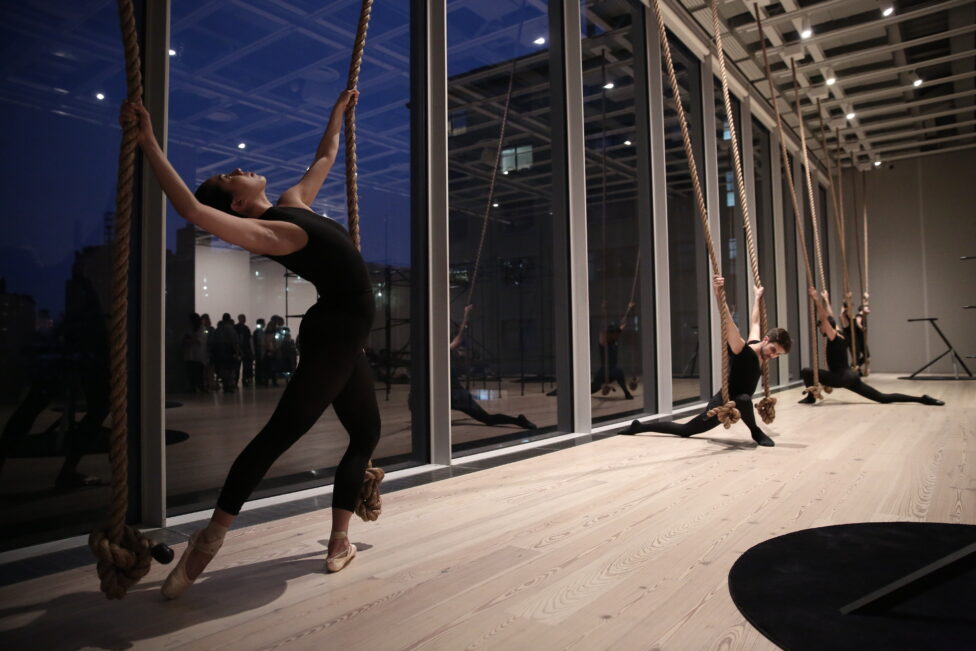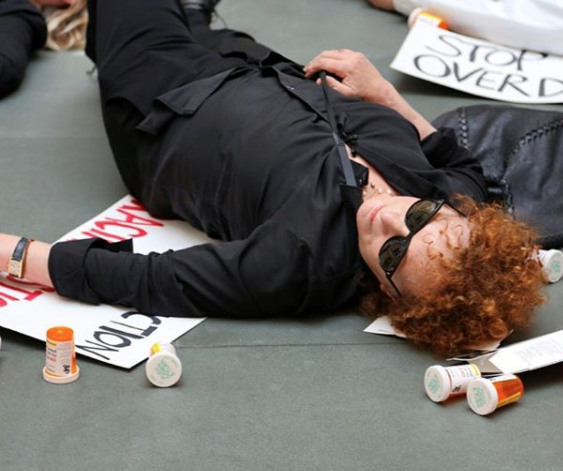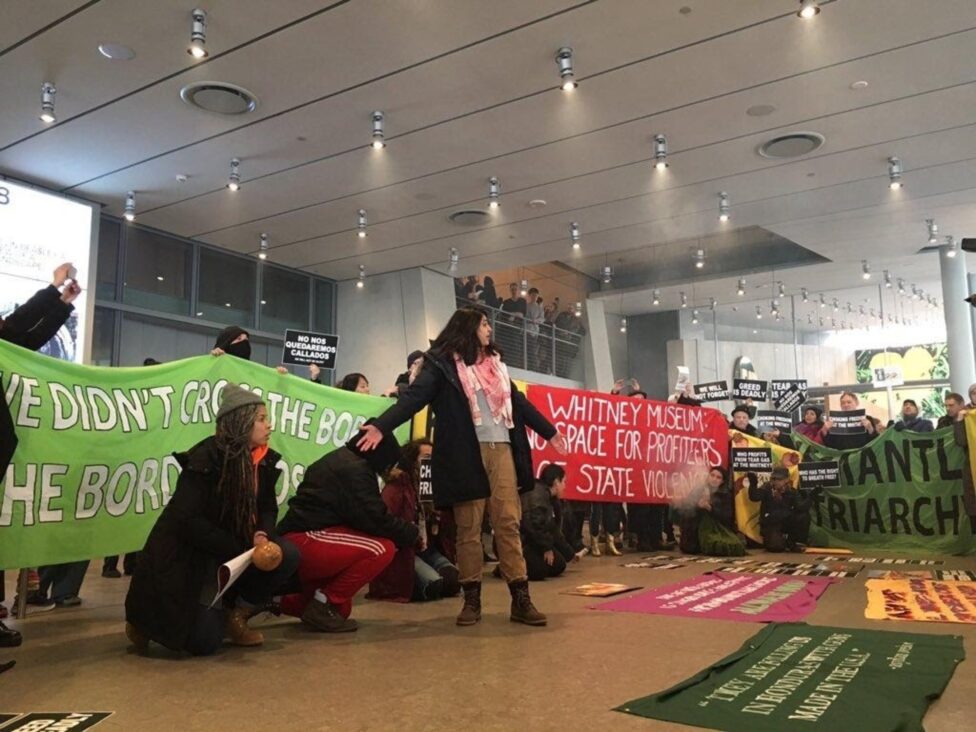The Museum as Site for Performance
For my thesis, I wrote about Brendan Fernandes’ 2018/19 The Master and Form as it was presented in the 2019 Whitney Biennial. A sculptural installation and live performance, this work explores themes of mastery, constraint, and freedom within ballet and was performed up to three times a week for the duration of the four-month exhibition. Spoiled with this regular schedule of performances, I committed to seeing the performance at least once a week from early June to mid-August. I set no expectations or benchmarks for myself, seeking only to be fully present during the hour-long performances.
The Master and Form was installed on the eastern edge of the Whitney’s fifth floor in a gallery with a wall of massive windows overlooking lower Manhattan’s skyline. This environment provided a dramatic backdrop for the three groups of sculptures that Fernandes’ cast of five dancers pushed on and against during the performances. The five “devices,” each an abstracted mold of a certain ballet position, prompted the dancers to shape themselves into the proper form. The playground-like central cage structure brought the full cast together and directed them to create movement with and through its multidirectional steel rods. After alternating between the devices and the cage, the dancers concluded the performance by elevating and suspending themselves in the air on the ten ropes that hung along the rear wall of windows.

Brendan Fernandes, The Master and Form, June 7, 2019. Photo by Paula Court. Performers pictured: Left to right: Mauricio Vera, Tyler Zydel, Josep Maria Monreal Vidal (in ball), Tiffany Mangulabnan, Amy Saunder. Image courtesy the artist and Monique Meloche Gallery, Chicago.
ID: five performers in black unitards inside a cage-like structure inside of a gallery
The almost entirely improvisational structure of The Master and Form allowed the dancers to choose whether to use Fernandes’ sculptures as supports to achieve an idealized ballet form or as points of resistance that could be used to create new forms beyond ballet’s canonical positions. This duality stems with Fernandes’ own experience with ballet as a young queer person of color: he found freedom in training and performing but was held back by not having the “right” body for ballet, whose standards for beauty are still entrenched in the whiteness of the form’s European origins.
The first few times I saw the piece, I was eagerly attentive to how it used the gallery as a site for the intersection of live theatrical performance and static museum display that cracked open ballet’s intense discipline and systemic exclusion of non-white bodies. But as my weekly pilgrimages to the gallery wore on through June and then July, it became increasingly apparent that I could not consider The Master and Form as a discrete object or performance liquidly suspended in a neutral white cube. The action against Warren Kanders, a member of the Whitney’s board, had been building well before my own study of The Master and Form began. If I was truly committed to being present with the work as it was installed in this museum, I could not ignore these contemporaneous events.

Brendan Fernandes, The Master and Form, June 7, 2019. Photo by Paula Court. Performers pictured: Left to right: Tiffany Mangulabnan, Mauricio Vera, Josep Maria Monreal Vidal. Image courtesy the artist and Monique Meloche Gallery, Chicago.
ID: five performers in black unitards in a row each hanging from a pair of ropes hung from the ceiling in a gallery
The Museum as Site of Protest
The resistance to Warren Kanders’ presence on the Whitney’s board had been hanging over the Biennial well before it opened in May 2019. As first reported by Hyperallergic in November 2018, Kanders’ law enforcement products company Safariland produced tear gas canisters that have been violently used against Central American asylum seekers at the US-Mexico border, amongst other locations worldwide. (1) In response, Michael Rakowitz, an artist who had been slated to participate in the exhibition, withdrew from the Biennial in February 2019, advancing his absence as a form of protest.
Protests against Kanders continued to escalate up to and through the Biennial’s opening in May 2019. Multiple letters demanding his removal from the board were signed by hundreds of scholars, critics, theorists, artists, and Whitney staff members, including many artists participating in the 2019 Biennial. The New York-based art activist group Decolonize This Place staged numerous protests in the Whitney’s lobby and galleries and organized “Nine Weeks of Art and Action” from March to May 2019, all with the ultimate goal of holding Kanders accountable for his actions and removing him from the museum’s board.
Writing about these unsanctioned museum protests in relation to The Master and Form, a museum-sanctioned performance, I think about how such protests could be considered performances on their own right. When Decolonize This Place protests occupied the Whitney’s lobby in December 2018, they radically disrupted its normal circulation by burning sage to represent Kanders’ production of tear gas and to cleanse the space of his company’s presence. In March 2019, they staged a performance in the museum’s galleries that similarly disrupted the norms of the space, unfurling banners and chanting “WARREN KANDERS MUST GO.”
Such forceful protests have occupied many other museums beyond the Whitney. To offer just one example, protestors led by Nan Goldin in May 2018 dumped empty pill bottles into a reflecting pool in the Metropolitan Museum of Art’s Sackler Wing and shouted demands for opioid harm reduction and treatment, once again rejecting the hushed din of the museum with their rallies for change. For me, it is difficult to consider the liveness of these emphatic unsanctioned protests without thinking of the liveness of official museum performances organized by curators. Both events alter and challenge usual norms for movement and sound in the gallery: Fernandes’ cast’s hyper-stylized ballet walks cut through the galleries and disrupt visitors’ normal flow of movement; museum protestors’ unabashedly forceful chants disrupt visitors’ normally subdued voices.

Nan Goldin, Photo by T.W. Collins
ID: woman with short red hair, wearing dark sunglasses, in black pants and shirt lying down on the ground in protest with prescription bottles scattered on the floor
The Kanders debate reached its peak in July, when Hannah Black, Ciarán Finlayson, and Tobi Haslett released “The Tear Gas Biennial,” a searing indictment of Kanders and a call for Biennial artists to withdraw their work from the exhibition to spur his resignation. (2) Two days later, eight Biennial artists did just that, stating how “the Museum’s continued failure to respond in any meaningful way to growing pressure from artists and activists has made our participation untenable” (3) and that “it terrifies me that my work is currently part of a platform that is now strongly associated with Kanders’ teargas-producing company Safariland.” (4)
Standing in the gallery during performances and sharing the Whitney’s increasingly contested space with the dancers, I scanned the dancers’ movement for any signs that the current events were impacting their own gestures or general presence, even as I knew there was no way to make any verifiable conclusions from such an improvisational performance. I further thought of how their livelihood as performers hired specifically to perform this work could be at stake. If Fernandes withdrew his work from the exhibition, or if so many artists withdrew their work that the entire Biennial imploded, what would the fate of these dancers be? Their contracts would certainly make evacuating The Master and Form from the exhibition much more difficult than taking a painting off a wall.
Unlike the dancers, Fernandes wasn’t physically present in the Whitney during the mounting protests, but he was still clearly aware of their stakes. Two days after the eight Biennial artists requested the withdrawal of their work, he made the following statement on his Instagram:
“Absence speaks volumes. In response to the recent NY times article announcing the withdrawal of 8 artists from the Whitney Biennial, I would like to express my full solidarity with their decision and their action. I would also like to add my admiration for the respect and solidarity expressed between these artists and the biennial curators. In my own work, the politics are in the doing. Working with collaborators, performers and institutions, I have a responsibility to approach the questions raised by these artists in dialogue with the others involved in my work. My hope is that the actions taken will result in deeper conversation and more direct action on the part of art institutions to address their complicated relationship with industries of oppression.” (5)
Here, Fernandes gestures to the greater responsibility he had to his work, a sentiment he had explicitly stated in an earlier interview: “The work and labor that went into the piece came from so many advocates, and if I pulled out, that would have been erased.” (6) These statements make clear that his dancers’ employment was never at risk. But the fact that he felt compelled to speak about the protests in direct relation to his own work further pushed me to understand The Master and Form as a part of rather than distinct from the debates surrounding the Whitney as a whole.
On July 25, less than a week after the eight Biennial artists requested the withdrawal of their work, Kanders announced his resignation from the Whitney’s board, ceasing any plans to physically remove artists’ work. This action was a triumph for all those who were outspoken about his removal but left open many questions about where boundaries laid in the ethics of museum funding, not to speak of Safariland’s continued manufacturing of military products that are used for state repression. But there was no denying how the 2019 Biennial would always be remembered to some degree as the “Tear Gas Biennial.”
To some, this firestorm detracted attention from the historic representation of artists of color in that year’s Biennial. But museum diversity and Kanders’ presence on the museum’s board should not be seen separately. To borrow a term from Gavin Grindon’s May 2020 New York Times editorial, museums give “social licenses” to their funders that paint them as benevolent and cultured members of society. Following this logic, protestors against Kanders were not just “cancelling” him as a lone individual; they were thinking systematically about how his presence on a prestigious museum board legitimized and normalized the wealth he earns from selling military equipment that is used against marginalized peoples around the world. Seen through this broad framework, it is ironic and even disparaging that Biennial artists were asked to share their work that presents and celebrates their diverse identities in a space that contributes to the normalization of state violence and oppression.
The Museum as Site of and for Reckoning
The action against and ultimate resignation of Kanders was arguably the most closely watched controversy in the art world in 2019. But its occurrence wasn’t a surprise –– each year brings its host of clashes that rally against museums’ institutionalized exclusivity –– nor was it a symptom of a recent “trend.” In her excellent 2018 book Whitewalling: Art, Race & Protest in 3 Acts, Aruna D’Souza traces how the present-day museums controversies are mirrored in 1969 protests by Black artists and activists against the Metropolitan Museum of Art’s exhibition Harlem on My Mind. The exhibition failed on many levels to genuinely incorporate the Black lives it put on display, an imbalance that can still be seen fifty-one years later in the overwhelming lack of racial diversity of many museums’ senior leadership and curatorial staff.
I imagine that many high-ranking museum officials secretly wiped their brows at the end of 2019, relieved that their institution had not been the center of a racial controversy that year that would’ve required crafting a PR strategy to reinforce their image as a museum that welcomes a “broad public.” But in 2020, no institution is exempt from scrutiny. In an irreversible watershed moment, museums are being held accountable by their employees and members of the public who demand that they go beyond mere messages of support and implement tangible changes. In the midst of a pandemic, protests have effectively gone virtual with accounts such as @changethemuseum providing open spaces for museum employees to share their personal experiences with racism and exclusion. And anyone with access to the Internet can turn an institution’s social media page into a site of protest and disruption, using the comment section to directly challenge statements they make about their action towards racial justice.
As museums begin to reopen, those who sounded their voices online will look expectantly to museums’ programming and initiatives to measure what action they are putting behind whatever official statements they released online. Museum performance, now a core part of many institutions, will certainly be one of these scrutinized outputs, and I imagine that artists invited into the museum to conduct “official” performances will be newly aware of their power as live performers. It will be difficult, if not impossible, for artists to treat the museum as a completely neutral site for the decontextualization and deconstruction of movement. Artists of color have certainly been aware of its false neutrality for years; when Gerald Casel, a queer Filipino-American choreographer, was invited to learn and create a response to Trisha Brown’s Locus for Hope Mohr Dance’s Bridge Project in 2016, he reflected how “as a dancer and choreographer of color, my body cannot be perceived as pure. My brown body cannot be read the same way as a white body, particularly in a white cube.” (7)
But the movement for Black lives over the past three months has reminded us that the struggle for true racial justice involves everyone; it is no longer acceptable for organizations to say “oh we don’t do that type of work” or “we’re not an organization that focuses on race.” I hope dancers and performers in museums will use their sanctioned platform as a sort of Trojan horse, using performance to thunderously sound the voices of protestors otherwise denied an official platform. I hope that artists will go beyond using performance to merely disrupt museum’s normal flow of movement and use it to more emphatically examine and call out who is excluded by such embedded codes of conduct. I hope that white artists will create performances that critically unpack and de-center their own whiteness and use the liveness available to them as performers to call in white museum visitors to do the same. And if performances from “precedented” times are re-staged in the museum, I hope they will be presented with attention to how they respond or don’t respond to the politics of the museum’s space.
Museums as a whole are endowed with a rich range of assets, from physical gathering spaces to far-reaching networks, that make them impactful platforms for amplifying artists and activist groups working to degrade and devolve systems of oppression. But they cannot act as a surface-level forum for discussion without also looking in the mirror and committing to wide-ranging and radical organizational changes that will catalyze progress towards genuine representation and inclusivity. Having such intimate access to all this potential energy, museum performance must use its natural gifts of adaptability and immediacy to ignite real action on all institutional levels and keep dialogue going to break through museums’ bureaucratic and systemic resistance to making real change.
Notes:
(1) Jasmine Weber, “A Whitney Museum Vice Chairman Owns a Manufacturer Supplying Tear Gas at the Border,” Hyperallergic, 27 November 2018
(2) Hannah Black, Ciarán Finlayson, and Tobi Haslett, “The Tear Gas Biennial,” Artforum, 17 July 2019
(3) Arunanondchai, Korakrit et al., “A Letter from Artists in the Whitney Biennial,” Artforum, 19 July 2019
(4) Christine Sun Kim, quoted in Colin Moynihan, “Eight Artists Withdraw From Whitney Biennial Over Board Memberʼs Ties to Tear Gas,” The New York Times, 19 July 2019
(5) Brendan Fernandes, Instagram post, 22 July 2019
(6) Colleen Hochberger, “An Interview with Brendan Fernandes, the Whitney Biennial Artist Who Uses Ballet to Channel BDSM and Queer Culture,” Artspace, 28 June 2019
(7) Gerald Casel, “Gerald Casel on Responding to Trisha Brown’s Locus,” Hope Mohr Dance, 1 November 2016





